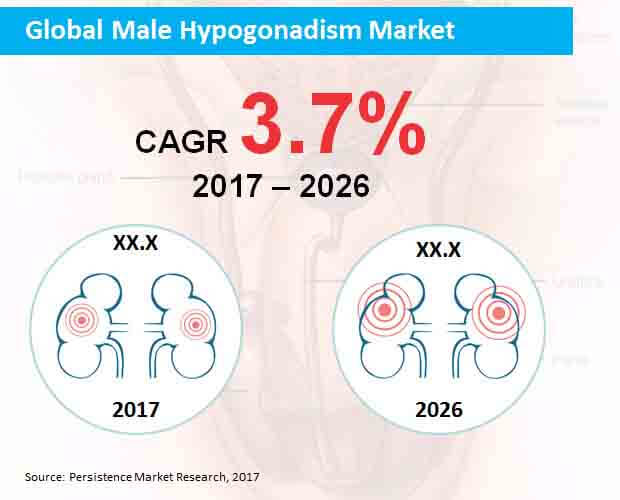Male Hypogonadism Market 2022
The Male Hypogonadism Market is meant to grow remarkably in the upcoming decade. NLP is the new “normalized” normal. NLP does deal with various interactions between human languages and computers. In other words, combining deep learning and analytical tools lets interpretation of medical data and improvement in the clinical decision for driving NLP’s growth in healthcare.
The Male Hypogonadism Market is bound to grow robustly in the years to come. With smart technology and 5G being increasingly adopted, the healthcare vertical is witnessing a paradigm shift. These technologies can thus increase the convenience quotient (CQ), as abysmal disruption happens in the patients’ lives. This convenience quotient would be the trend running in the healthcare vertical shortly.
According to Persistence Market Research’s new report, global male hypogonadism market is slated to exhibit a steady expansion throughout the forecast period (2017-2026). Revenues from the global market for male hypogonadism are estimated to exceed US$ 3,300 Mn by 2026-end.
Get Sample Copy of this Report@ https://www.persistencemarketresearch.com/samples/22303
Company Profiles:
- Endo International Plc
- Eli Lilly and Company Ltd.
- AbbVie, Inc.
- Pfizer, Inc.
- Merck KGaA
- Allergan Plc
- Sun Pharmaceutical Industries Limited
- Ferring B.V.
- Others

Request for Methodology@ https://www.persistencemarketresearch.com/methodology/22303
Governments Taking Initiatives to Spread Awareness about Male Hypogonadism Therapeutics
Lack of sex hormones, usually referred to as male hypogonadism has resulted into many health risks that include osteoporosis, heart disease, and cardiovascular diseases on the back of thinning of bones. Global male hypogonadism market comprises several patented brands that currently have high market penetration. Proliferation in geriatric population in tandem with rising incidences related to rheumatoid arthritis and obesity have been primary factors affecting prevalence of male hypogonadism globally. Mounting incidences of testosterone deficiency in male population is a key factor that prevalence of male hypogonadism has surged worldwide. Several governments around the world have been taking initiatives to spread the awareness on hypogonadism treatment procedures, for example – testosterone replacement therapy (TST),in order to relieve the painful burden on patients and their families.
As low testosterone levels are increasingly associated with exacerbation of chronic conditions, it further results into disorders apropos to hypothalamic-pituitary-gonadal axis. Advent of TST has however enabled reduction in cases of male hypogonadism considerably. With growing awareness related to its treatment among patients, the market is likely to gain an uptick during the forecast period. Rising availability of the selective androgen receptor modulators (SARMs) has further sustained the market expansion. The development and high availability of SARMs has led toward the provision of improved treatment procedure to patients having androgen deficiencies, thereby influencing the market growth.
North America will continue to Dominate Global Male Hypogonadism Market
North America will continue to dominate the global male hypogonadism market, with more than one-third revenue share during the forecast period. In addition, revenues from the male hypogonadism market in North America will exhibit the fastest expansion through 2026, as compared to those from all the other regional segments comprised in the report. Europe and Asia-Pacific excluding Japan (APEJ) are also expected to remain lucrative for the male hypogonadism market. The market in APEJ will ride on a slightly higher CAGR than that in Europe through 2026.
Topical gels are expected to remain the most lucrative among drugs available for treatment of male hypogonadism globally, with sales projected to register the fastest expansion through 2026. Injectables will also remain a major revenue contributor to the market. Sales of injectable and transdermal patches are poised to reflect an equal CAGR through 2026.
Access Full Report@ https://www.persistencemarketresearch.com/checkout/22303
Testosterone Replacement Therapy to Remain Preferred among Patients
Based on therapy, testosterone replacement therapy is expected to remain preferred among patients with male hypogonadism worldwide. Roughly 66% revenue share of the market is expected to be held by revenues from testosterone replacement therapy by 2026-end. Revenues from gonadotropin replacement therapy will remain slightly more than half revenues gained from testosterone replacement therapy throughout the forecast period.
Klinefelter’s syndrome is expected to remain the most prevalent disease type observed in the male hypogonadism market, and revenues from treatment of this disease will exceed US$ 1,800 Mn by 2026-end. Kallmann Syndrome and Pituitary Adenomas among disease types will also account for major revenue shares of the market by 2026-end.
Nature of global male hypogonadism market has been observed to be highly competitive. This can be mainly attributed to occupancy of many small as well as large suppliers. New companies entering the male hypogonadism market are leveraging opportunities related to treatment developments and innovations. Strategic alliances are likely to remain strong among vendors for producing and marketing drugs worldwide, thereby increasing their market reach.
Contact us:
Persistence Market Research
Address – 305 Broadway, 7th Floor, New York City,
NY 10007 United States
U.S. Ph. – +1-646-568-7751
USA-Canada Toll-free – +1 800-961-0353
Sales – sales@persistencemarketresearch.com
No comments:
Post a Comment